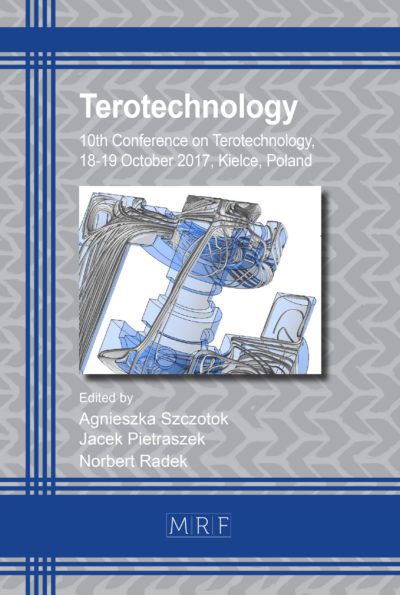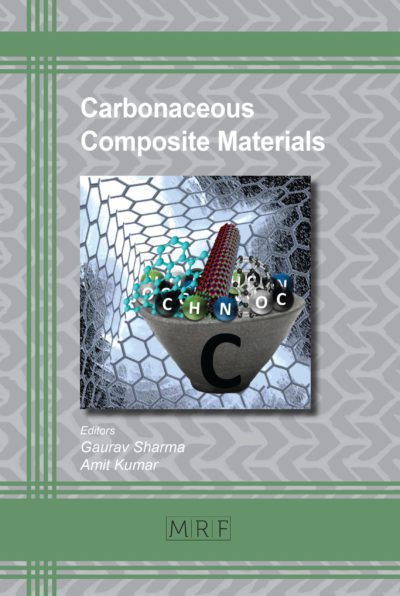Effect of process parameters on mechanical properties of CFRP components obtained by filament winding process
Marina Andreozzi, Daniele Ciccarelli, Massimo Di Pietro, Tommaso Mancia, Chiara Mignanelli, Michela Simoncini
Abstract. The present paper investigates the effect of FW process parameters, such as winding angles and process speeds, on the mechanical properties of wound Carbon Fiber Reinforced Polymers (CFRP) components. The X-Winder machine was used to realize the CFRP tubular parts with different winding angle values (30°, 60°, 90°) and process speeds, obtained varying the combination of the carriage and mandrel speeds. To investigate the mechanical properties of the wound components, rings specimens were obtained from the tubular structures by cutting operations and tensile tests were performed according to the ASTM D2290 international standard. The results show that an increase in the winding angle leads to a relevant improvement in tensile properties; whilst a slight rise in those properties can be achieved by increasing the process speeds.
Keywords
CFRP, Filament Winding, Ring Tensile Test, Winding Angle, Mechanical Properties
Published online 5/7/2025, 10 pages
Copyright © 2025 by the author(s)
Published under license by Materials Research Forum LLC., Millersville PA, USA
Citation: Marina Andreozzi, Daniele Ciccarelli, Massimo Di Pietro, Tommaso Mancia, Chiara Mignanelli, Michela Simoncini, Effect of process parameters on mechanical properties of CFRP components obtained by filament winding process, Materials Research Proceedings, Vol. 54, pp 526-535, 2025
DOI: https://doi.org/10.21741/9781644903599-57
The article was published as article 57 of the book Material Forming
![]() Content from this work may be used under the terms of the Creative Commons Attribution 3.0 license. Any further distribution of this work must maintain attribution to the author(s) and the title of the work, journal citation and DOI.
Content from this work may be used under the terms of the Creative Commons Attribution 3.0 license. Any further distribution of this work must maintain attribution to the author(s) and the title of the work, journal citation and DOI.
References
[1] M. Holmes, Carbon composites continue to find new markets, Reinforced Plastics 61 (2017) 36–40. https://doi.org/10.1016/J.REPL.2016.12.060
[2] P. Singh, V. Raghavender, S. Joshi, N. Pooja Vasant, A. Awasthi, A. Nagpal, A. jasim Abd al-saheb, Composite material: A review over current development and automotive application, Mater Today Proc (2023). https://doi.org/10.1016/J.MATPR.2023.11.012
[3] J.C. Kelly, J.L. Sullivan, A. Burnham, A. Elgowainy, Impacts of Vehicle Weight Reduction via Material Substitution on Life-Cycle Greenhouse Gas Emissions, Environ Sci Technol 49 (2015) 12535–12542. https://doi.org/10.1021/ACS.EST.5B03192/SUPPL_FILE/ES5B03192_SI_001.PDF
[4] P. Boisse, R. Akkerman, P. Carlone, L. Kärger, S. V. Lomov, J.A. Sherwood, Advances in composite forming through 25 years of ESAFORM, International Journal of Material Forming 2022 15:3 15 (2022) 1–30. https://doi.org/10.1007/S12289-022-01682-8
[5] B. Iacopo, M. Chiara, S. Michela, V. Tommaso, Life cycle analyses of a composite towbar realized via filament winding and comparison with traditional metallic alternatives, Sustainable Materials and Technologies (2024) e00980. https://doi.org/10.1016/J.SUSMAT.2024.E00980
[6] S. Carosella, S. Hügle, F. Helber, P. Middendorf, A short review on recent advances in automated fiber placement and filament winding technologies, Compos B Eng 287 (2024) 111843. https://doi.org/10.1016/J.COMPOSITESB.2024.111843
[7] M.A. Mateen, D.V.R. Shankar, M.M. Hussain, Design and Development of Low Cost Two Axis Filament Winding Machine, Journal of Advanced Manufacturing Technology (JAMT) 12 (2018) 117–126. https://jamt.utem.edu.my/jamt/article/view/1862 (accessed February 19, 2024).
[8] I. Bianchi, A. Forcellese, F. Galliani, L. Greco, C. Mignanelli, G. Trevisan, Process and structural simulation for the development of a pressure vessel through filament winding technology, Materials Research Proceedings 28 (2023) 347–556. https://doi.org/10.21741/9781644902478-38
[9] H. Purnomo, T.P. Soemardi, H.D.S. Budiono, H.B. Wibowo, M. Ibadi, THE FILAMENT WINDING METHOD’S FINISHING PROCESS IMPACT ON HIGHFIDELITY SPECIMENS: HOMOGENITY OF DENSITY, FIBER VOLUME FRACTION, OUTER SURFACE ROUGHNESS AND TENSILE STRENGTH, Eastern-European Journal of Enterprise Technologies 6 (2023) 43–51. https://doi.org/10.15587/1729-4061.2023.288025
[10] L. Gemi, M. Azeem, Ş. Yazman, M. Kayrıcı, O. Gök, Investigation of Mechanical Properties and Damage Development of Filament Wound GFRP Composite Pipes by Ring Tensile Test, Necmettin Erbakan Üniversitesi Fen ve Mühendislik Bilimleri Dergisi (2024). https://doi.org/10.47112/neufmbd.2024.34
[11] V. Srebrenkoska, S. Risteska, M. Mijajlovikj, Thermal Stability and Hoop Tensile Properties of Glass Fiber Composite Pipes; Thermal Stability and Hoop Tensile Properties of Glass Fiber Composite Pipes, n.d. www.ijert.org
[12] S. Srebrenkoska, F. Kochoski, V. Srebrenkoska, S. Risteska, R. Kotynia, Effect of Process Parameters on Thermal and Mechanical Properties of Filament Wound Polymer-Based Composite Pipes, Polymers 2023, Vol. 15, Page 2829 15 (2023) 2829. https://doi.org/10.3390/POLYM15132829
[13] G. Perillo, R. Vacher, F. Grytten, S. Sørbø, V. Delhaye, Material characterisation and failure envelope evaluation of filament wound GFRP and CFRP composite tubes, Polym Test 40 (2014) 54–62. https://doi.org/10.1016/j.polymertesting.2014.08.009
[14] V.S.S. Charan, A.V. Vardhan, S. Raj, G.R. Rao, G. V. Rao, S.M. Hussaini, Experimental Characterization of CFRP by NOL Ring Test, Mater Today Proc 18 (2019) 2868–2874. https://doi.org/10.1016/J.MATPR.2019.07.154
[15] G.M.H. Abed, C. Pinna, J.P. Foreman, S.A. Hayes, Characterisation of the tensile and fracture properties of filament wound carbon fibre rings, 16th European Conference on Composite Materials, ECCM 2014 (n.d.) Seville
[16] E. Jacquet, F. Trivaudey, D. Varchon, Calculation of the transverse modulus of a unidirectional composite material and of the modulus of an aggregate. Application of the rule of mixtures, Compos Sci Technol 60 (2000) 345–350. https://doi.org/10.1016/S0266-3538(99)00128-1
[17] Test Method for Apparent Hoop Tensile Strength of Plastic or Reinforced Plastic Pipe, (2019). https://doi.org/10.1520/D2290-19A
[18] S. Lee, S.H. Kim, S. Kim, J. Choi, H.J. Choi, Hoop tensile strength of tubular carbon fiber reinforced silicon carbide matrix composites, Ceram Int 44 (2018) 17087–17093. https://doi.org/10.1016/J.CERAMINT.2018.06.157
[19] I. Barsoum, K.F. Al Ali, A procedure to determine the tangential true stress-strain behavior of pipes, International Journal of Pressure Vessels and Piping 128 (2015) 59–68. https://doi.org/10.1016/J.IJPVP.2014.11.002
[20] Y. Zhao, P. Druzhinin, J. Ivens, D. Vandepitte, S. V. Lomov, Split-disk test with 3D Digital Image Correlation strain measurement for filament wound composites, Compos Struct 263 (2021) 113686. https://doi.org/10.1016/J.COMPSTRUCT.2021.113686
[21] J.F. Chen, S.Q. Li, L.A. Bisby, J. Ai, FRP rupture strains in the split-disk test, Compos B Eng 42 (2011) 962–972. https://doi.org/10.1016/J.COMPOSITESB.2010.12.015
[22] G. Perillo, R. Vacher, F. Grytten, S. Sørbø, V. Delhaye, Material characterisation and failure envelope evaluation of filament wound GFRP and CFRP composite tubes, Polym Test 40 (2014) 54–62. https://doi.org/10.1016/J.POLYMERTESTING.2014.08.009
[23] I. Bianchi, A. Forcellese, T. Mancia, C. Mignanelli, M. Simoncini, T. Verdini, Effect of Heat-Shrinkable Tape Application on the Mechanical Performance of CFRP Components Obtained by a Filament Winding Process, Journal of Composites Science 2024, Vol. 8, Page 535 8 (2024) 535. https://doi.org/10.3390/JCS8120535














